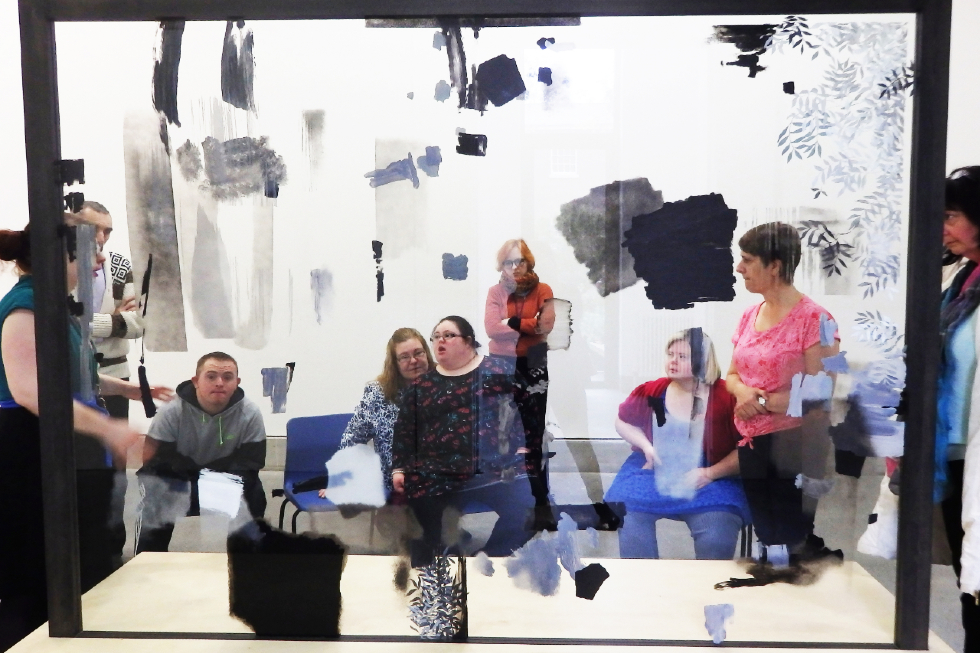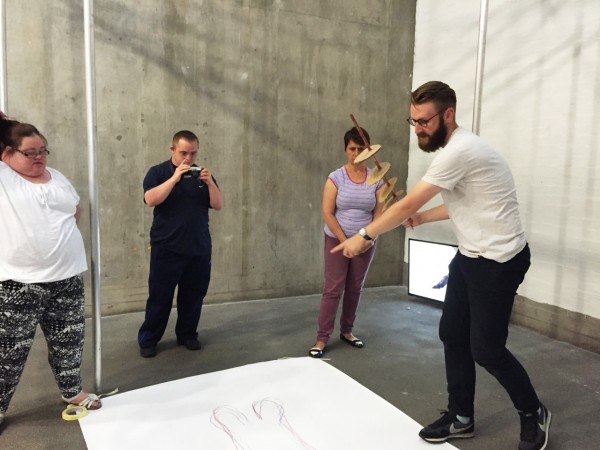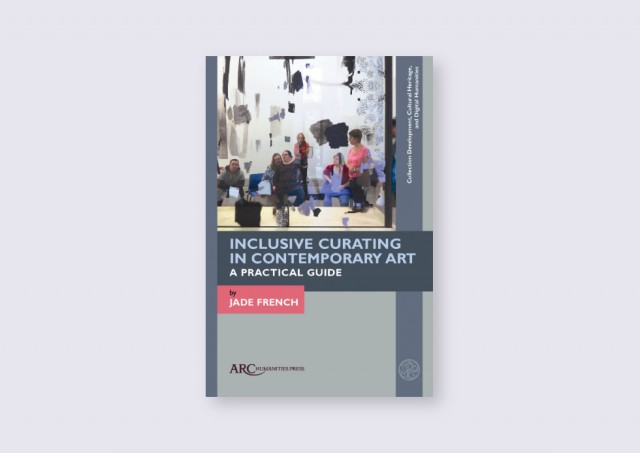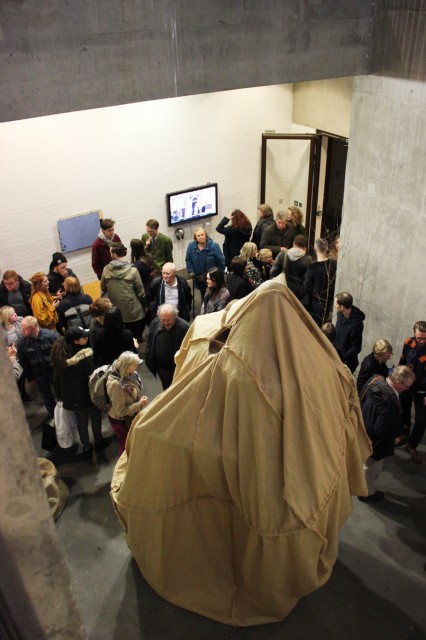Towards Inclusive Curating: Who gets to Curate Exhibitions?

How do we open up the field of curating – a position of gatekeeping and complicated power dynamics? With the publication of her new book, Inclusive Curating in Contemporary Art, Jade French talks to Bluecoat’s Head of Programme, Marie-Anne McQuay…
To many, curating is a closed and mystifying aspect of exhibition-making. Here, artist, curator and author Jade French discusses her latest book, Inclusive Curating in Contemporary Art: A Practical Guide, with Marie-Anne McQuay, Head of Programme, Bluecoat and Artistic Director of Wales in Venice 2019. The book, intended to make curating accessible to people without a traditional arts education background, features a range of practical resources and key debates. These are grounded in a case study, Auto Agents. French and McQuay begin by discussing the case study and book over email during lockdown.
Jade French: It doesn’t feel that long ago that I was stood in Bluecoat’s cavernous gallery space with the Auto Agents, witnessing the alchemy of collaboration unfold between a group of curators with learning disabilities and the artists they had commissioned. The 2016 exhibition Auto Agents was the first of its kind to really pay attention to how curating might be reimagined as an accessible practice with learning disabled people, to question what we think of as curating, and crucially, who we think of as potential curators.

As the project’s initiator and facilitator, I had the sizeable task of devising a process by which to make curating inclusive and accessible; to break it down into its constituent parts for these new curators to review, critique and ultimately, re-engineer. Curating, after all, is an ever-changing terrain occupying a broad scope of activities, practices, and professions. Yet, at the same time, it remains largely an exclusive practice for a privileged few synonymous with ideas of authority, gate-keeping, and expertise.
As these legacies increasingly jar with a sector which seeks to promote representation and diversity of its artists and audiences alike, many in the art world have sought to widen participation with curating and programming, but to varying degrees of quality and success. It is here where I believe the curatorial approaches generated via Auto Agents can make a contribution. Not just through demonstrating an applied process to inclusively curate, but in ways which are equitable and ethical; recognising the intimate relationship between not only what but how work is done.
Marie-Anne McQuay: Looking back at Auto Agents, what experience of art and culture did the individuals who made up the curatorial group – Tony Carroll, Diana Disley, Hannah Bellass, Leah Jones and Eddie Rauer – bring to the table?
JF: The curatorial group was made up of five individuals who were recruited from the memberships of two organisations: a learning disability self-advocacy group called Halton Speak Out and Bluecoat’s inclusive arts programme Blue Room. The idea behind this was to bring together two distinct, but equally valuable skill sets for curating, into dialogue: knowledge and skills in self-advocacy (politics, critical skills, speaking up for yourself, making decisions) with arts practice (creative self-expression, artistic technique, interpretation, collaboration).
Prior to Auto Agents, Leah and Hannah from Halton Speak Out had rarely engaged with curating or spent much time within art galleries. They were, however, both involved with the performing arts and Leah in particular was heavily involved with activism and brought to the table a wealth of experience in working with local authorities and support providers to communicate and advance the rights of learning disabled people. In contrast, the curators from Blue Room were highly experienced in the visuals arts and had spent much time visiting exhibitions and working with artists via Bluecoat, and so contributed expertise in both making and interpreting art and artistic collaboration.
How did you break down what curating is with them?
Earlier in my career, before working in the cultural sector, I was a support worker and carer for learning disabled people. This was when the UK’s 2001 personalisation agenda had recently overhauled social care planning and delivery for learning disabled people, and a key part of this policy was `person-centred planning`. This advocated that people’s care should no longer be decided on solely by professionals, but instead, determined by the individuals themselves who should be empowered to assess their own needs and shape their own support. This is achieved through a range of practical approaches and techniques which I was able to train in and spent many years using in my support work.
This experience greatly informed my thinking around curating with this group. During this project, I re-engineered approaches and techniques found in social care and applied them to curating in quite a unique way. The overall ‘inclusive curating` process detailed in the book, for example, is based on a person-centred planning tool called PATH. This is a creative planning tool used with learning disabled people that utilises graphic facilitation to collect information to inclusively plan for the future. Crucially, PATHs are group activities and work really well to draw together different types of expertise (typically health, support, housing, relationships) to plan towards a goal, lending itself well to the relational aspect of a curator’s role.
MMc: What made you decide to commission new work rather than borrow works? What were the benefits and drawbacks of this approach?
JF: Commissioning offers a unique opportunity for curators to collaborate with artists. This was a big benefit for the project as it allowed the curators to be a part of the artworks‘ development and see/experience – in quite a literal way – how artists work and generate ideas. This helped to demystify tasks and decisions: a core principle of person-centred planning. For Auto Agents, both of the commissioned artists – James Harper and Mark Simonds, respectively – developed their work through several workshops with the curators who were able to contribute their own ideas and feedback. Ultimately, this presented a pathway to a more dynamic, deeper and meaningful understanding of the finished work and I feel the artists learned a lot about what it means to embed access in their practice.
The relationship between artists and curators is a complex one, however. Commissioning work presents authorial challenges as well as practical ones. I discuss lots of examples in the book! One that comes to mind is when one of the artists experienced difficulties with installing their commission. A key part of their piece (which had been made to order) had not arrived on time and so they had to reconfigure an aspect of their work on site very quickly as the exhibition was due to open to the public. These changes involved a myriad of practical and aesthetic decisions and certainly presented a challenge for the project in terms of making these changes to work understandable to the curators in a short time frame. These more administrative aspects of a curator‘s role: budgets, time management and problem solving, were difficult to make accessible at times.

MMc: How are you influenced both by developments within curating – the inclusion of participatory and social practices, the re-evaluation of the Western Canon, the performative and educational turn in curating – and also by other fields such as direct social activism?
JF: Before this project I had not formally studied curating, my experience was largely through my own work being curated as an artist. However, my interest in curating grew the more I began supporting learning disabled artists. In a range of supported studios, I saw incredible, thoughtful facilitation taking place, yet, when it was time to exhibit their work the artists lost agency and the ‘professionals’ took over. Here, I witnessed curation as gatekeeping and power which worked to maintain inequalities. Initially, it was this which I was keen to challenge, but the question of who gets to be a curator and how we can practically widen participation with this practice is one that resonates beyond learning disabled people and, I feel, speaks to increased calls to pluralise, decolonize and queer our collections and galleries to challenge the status quo of the art world.
And what was brilliant, was the curators absolutely did do this. One example I discuss in the book is when they decided not to use any text in their exhibition, so no labels, artists’ statements, catalogues, wall texts etc., and instead made a single collaborative video with the artists to act as interpretation along with a handout and vinyl pictorial signage to help guide visitors around the work. I remember people saying, “that will be confusing, the public like text labels!”. But for the group, this was a political statement. The truth is that some did find it confusing as not all visitors watched the video, but for the curators this was a risk they were willing to take.
For others, the lack of text was refreshing. One review of the exhibition described how, “It made for one of the most accessible exhibitions Bluecoat has ever shown, where the viewers got presented with work that was absolutely to be taken at face value in the most blunt way.” The non-existence of text in Auto Agents challenged the norms of the gallery which often rely on reading and ‘artspeak’. The group chose to use their capacity as curators to orientate visitors to their ways of understanding art, which emphatically for them, is not through text, which I feel opened up new possibilities to ‘know’ about art.
So, for me, the strength of this work is that we are influenced, and bringing in a specific set of interests and reference points not typically found in curating – such as social policy and care, disability politics, activism, self-advocacy and DIY practices – in order to do things differently.

MMc: Having been an exhibiting artist, a curator and co-director of an artist-led space, how would you like to best apply your broad experience next?
JF: I first and foremost consider myself as an artist-facilitator. As the arts and cultural sector seeks to get to grips with inclusion, I sense there will be a greater need for facilitators. I hope to develop this area of work through creating training and perhaps drawing together a national network of artist-facilitators, as for too long this work has been greatly undervalued. Equally, I‘m also really interested in ideas of curatorial devolution so would be interested in exploring hybrid curatorial-facilitator-access roles within institutions too. There’s lots to do!
Inclusive Curating in Contemporary Art is available now via Arc Humanities Press. Get 50% off until December 2020 with discount code ARCFRENCH50
Images, from top: Curators researching in Bluecoat during Niahm O’Malley’s exhibition Glasshouse; Curators working with James Harper on his commission; Book Cover; Auto Agents launch at Bluecoat





